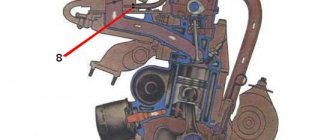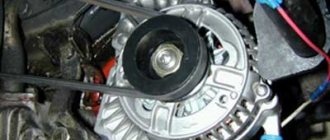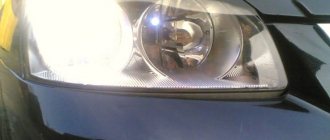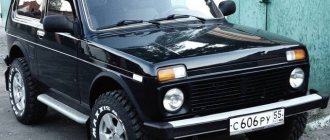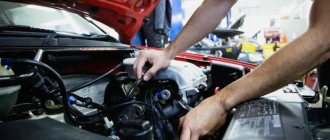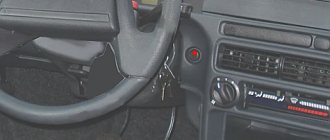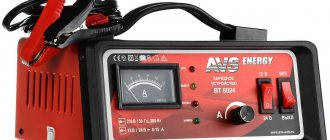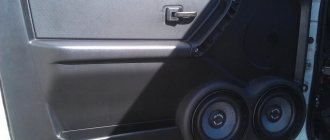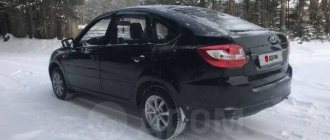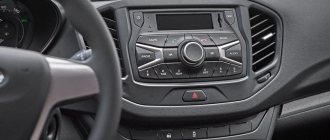As you know, the paintwork of a car performs not only a decorative function, but also a protective one, preventing metal corrosion. Painting at a service station now costs from 5,000 rubles and more per element. This figure is made up of the cost of consumables and paints, the need to use special tools and equipment, as well as fees for the work of a car painter. Whatever one may say, it's expensive. Therefore, many car owners are thinking about how to tint their car themselves.
This article will help you with this. In it we will tell you how to restore a car’s paintwork if “bugs” or scratches appear on it.
Cleaning a damaged area of a car for touch-up
If the defect that appears is a “bug”, in fact, it is a section of swollen paintwork, under which there is a source of metal corrosion. It is best to clean it with a special attachment on an electric drill that looks like a brush:
- The thickness of the wire on such a nozzle can be from 0.3 millimeters to 0.5 millimeters
- The brush is 0.5 millimeters thick, more rigid, but in practice the result of working with it, compared to a 0.3 millimeter nozzle, is exactly the same
If painting a car is local, then it is best to use a brush with a thin wire and a small diameter. This will make it possible to process small areas without damaging the factory paintwork where it is in good condition.
In order to remove more deeply ingrained rust, you can use an angle grinder with a sanding disc. If you don’t have one, the second step described below will help. It should be repeated several times until you are satisfied with the result.
Removing rust, applying putty and primer
To remove corrosion using a chemical method, you can use several means, for example, various rust converters. However, the most effective of them is the B-52 Rust Destroyer. It should be noted that the composition does not work as quickly as described in the attached instructions, but you will see the result with the naked eye.
The reagent converts rust into a black substance, which must be removed with an electric drill with the same attachment, which looks like a small (0.3 millimeter) brush. Then wipe the area to be treated with solvent. It is not advisable to wash it with water, as indicated in the instructions, because unprotected metal will quickly become covered with new rust.
If necessary, repeat the procedure as many times as needed.
Further, the preparatory work, when local touch-up of the car is performed, if the damage is deep, it is necessary to continue leveling the surface with a special automotive putty. When the defect is superficial, the element can be primed immediately. It is best to use primer for this in an aerosol can, for example, the “Body” brand. Protect nearby areas of the car that will not be treated with plastic film, securing it with masking paper tape.
Spray putty and primer in a place protected from wind and dust, as well as other atmospheric influences. A spray booth is best suited for this. But, if it is not there, then work can be done in a garage that is suitably prepared for this.
Apply 2-3 layers of primer. After each layer has dried, sand it with fine sandpaper. Then thoroughly wipe the surface to be treated with solvent.
Methods of protection against rust
The appearance of rust on the metal body is a natural process that cannot be avoided. There are brands of vehicles that are corrosion-resistant, but if a scratch appears on the body, protective measures must be taken immediately. Under normal conditions, drivers just need to follow simple recommendations:
Anti-corrosion treatment of the bottom helps. It is recommended to order it immediately after purchasing the car before leaving the dealership. All of the listed methods for protecting the vehicle body from destruction due to metal oxidation are accessible and simple. No skill required for this.
It is enough to test the technology once, and the appearance of red spots will not frighten the car owner. The prospect of handing over the car for major expensive repairs is excluded. The machine will work the planned limit with minimal costs for preventive measures.
Source
Touch-up and varnishing of a car element
Actually, touching up a car with your own hands can be done in two ways: either using a small paint sprayer or an aerosol can. The second method is, of course, much simpler.
Before applying paintwork, sand the surface to be restored again with fine-grained sandpaper, degrease with a solvent, preferably white spirit, and then wipe with a dust-removing cloth. When painting, keep the can at a distance of 30 cm from the surface of the element. Spray the dye in thin layers to avoid drips. A total of 3 layers of paint will need to be applied.
After this stage, you can start spraying the varnish. This colorless composition must be applied to already dried paint. If the composition is normal, start the operation after 15-20 minutes; if the paint is metallized, then the recommended period for drying is 30 minutes. Spray varnish is applied in the same way as the dye itself. You will need to spray two layers of the composition. A few days after the car has been touched up, if desired, you can polish the treated element using a polishing machine and a special paste.
The bodies of all cars are subject to corrosion, but it can and should be combated. In this article I will tell you how to independently get rid of rust on the body of your favorite car, and thereby extend its life and improve its appearance. I will tell and show everything using the example of my own repairs. I did everything for the first time and it turned out very well. So, I think any car enthusiast can repeat this and save a lot of money on body repairs. So let's get started...
For repair you will need:
— Sandpaper coarse (120) and fine (400 and 600); — Brushes for metal, but it’s better to use a grinder or an electric drill with a special attachment; — Degreaser; — Rust converter (Tsinkar) — Putty with fiberglass; — Regular putty; — Anti-corrosion primer in a can; — Paint in a can; — Masking tape and more newspapers; — Clean rags for degreasing;
This is what my car looked like before the repair:
Before starting work, you need to wash the car thoroughly so that all damaged areas are visible. After you have washed the car and prepared everything you need, you can begin.
1.
Clean the surface well to remove rust and old paint.
It is advisable to use a grinder or an electric drill with a special attachment for this; this will save you a lot of effort and time, and the repair will be of better quality.
How to paint over chips on a car without completely painting the body?
Operating a car inevitably causes minor damage to the paintwork. Chips caused by high-speed travel and flying insects or pebbles cause more serious damage if they are not repaired in time. Corrosion processes begin under the paint and are invisible to the naked eye. This is precisely why numerous chips that are not painted over are scary. They are centers of rapid destruction of the body.
In order not to lose the integrity of the body and not to reduce the cost of the car on the secondary market to the limit, as well as to maintain the good appearance of the car, it is necessary to eliminate all chips that have arisen before they lead to irreversible consequences. It is much easier to paint over minor damage to the paintwork than to fix problems with rotten areas in the body. There are three different options for dealing with chips, which depend on the degree of damage to the body.
Option 1: a large number of chips on one body part
The most susceptible place in a car to this type of damage is the hood. This is where the greatest influence of stones flying from under the wheels of oncoming cars is concentrated, and any chip will be very clearly visible. Therefore, problems that arise must be resolved quickly and efficiently. Moreover, on a flat hood, poor painting of a chip will be very visible, so you need to take into account the high quality of work to eliminate such problems.
If there is a large amount of damage, it makes no sense to carry out spot body repairs. Indeed, in this case, your hood will be covered with spots or dots with a slightly different color. It is better to paint the entire body part completely. The painting process is quite complicated, but you can do it yourself:
- if the body part is easily dismantled, separate it from the car to avoid painting other elements;
- otherwise, cover all adjacent elements with masking tape and newspapers or film;
- thoroughly rinse and dry the surface of the workpiece;
- sand the paint and primer using fine sandpaper with a constant supply of water (you can use a spray bottle);
- dry and degrease the metal surface with a solvent;
- apply a layer of primer (we’ll talk more about painting technology below);
- wash the soil using the finest sandpaper and water;
- degrease the surface again and apply a layer of paint;
- If necessary and desired, use a special varnish after painting.
About a month after completing this procedure, you can soft polish the painted part, as well as polish the rest of the body to bring the car to a uniform color. It is better to select paint from a company that has computer equipment and provides accurate results.
The technology for applying primer and paint is simple. You can use paint in cans or apply it with a sprayer. Do not concentrate the spray on one point, making lateral movements, and also make sure that the can or gun is at the same distance from the car body (approximately 20-25 centimeters). This will save you from having to deal with paint drips.
There is rust on the wheel arches - what to do and how to prevent it?
If the doors or hood can be replaced without losing the integrity of the body skeleton, then with arches things are different. The front fenders can theoretically be changed without much loss (not on all car models), but the rear fenders in most cases are part of the side of the car and cannot be changed separately. Therefore, it is necessary to monitor the “health” of these parts. As soon as you notice the presence of rust, you need to take action to eliminate the effects of rust and to fully protect against such unpleasant destruction. Unfortunately, rust manifests itself already at a time when it will be impossible to eliminate it simply with the help of preventive measures. In this situation, you will have to deal with the manifestations of corrosion and spend some time eliminating defects. But the method of this elimination depends on the car, budget and your desire to extend the life of your iron horse.
Wheel arches rust due to damage to the paintwork. The cause may also be the destruction of the corrosion protection layer on the inside of the body elements. In the latter case, you will notice rust only after it becomes through and spreads throughout the entire thickness of the metal part. In case of external damage, the situation can be noticed earlier and action can be taken even before corrosion holes appear through the body.
The following aspects and possible causes of rust on arches should be taken into account:
Pebbles can fly into the arch from under the wheel, scratching off and damaging the paint. This leads to the fact that the protection of the metal surface is weakened and microcracks appear. Through these holes, water enters the metal and begins to destroy it. The destruction process can last for years on cars with thick metal, or it can take several weeks if the car’s metal is thin. Modern cars do everything with thin metal, so its resistance to corrosion is very limited. This places even greater responsibility on the car owner for maintaining the car.
How to remove rust from a car body and stop its spread?
Working with a car body is the most important activity for every vehicle owner, and it is very important not to miss the moment when this process becomes necessary. To remove rust from a car body, as well as neutralize the effects of corrosion on metal, you need to know a few little secrets of performing body work. The procedure for cleaning small germs of rust and rot can be neutralized yourself. The main thing is to do everything in accordance with professional requirements.
Today on the automotive market you will find a lot of useful products for working with corrosion. You can often remove rust from a car body using special chemicals, but this approach has a lot of nuances. So, let’s look at the main features of repairing the body of your car and saving it from corrosion.
Getting ready for repairs - what to buy at the car store?
The rust removal process involves not only working with corrosion, but also further aesthetic finishing of the site of metal destruction. You need to choose one of the rust neutralization methods, and then use putty, primer and paint to give the body part a normal appearance. To complete the first stage of work, that is, removing corrosion, you will need a set of tools and products in accordance with the chosen method:
- coarse sandpaper and a holder for its more efficient use (suitable for removing corrosive areas on flat areas of the body);
- a special circle for an angle grinder, which carefully removes a small layer of metal and allows for thorough repairs of the damaged area;
- a metal brush is the roughest way to remove corrosion, which does not always bring the damaged area into ideal condition;
- a special liquid called “rust neutralizer” - there are plenty of such products in stores, but their effectiveness remains a controversial issue.
Causes and places of rust on a car body
Metal deteriorates due to oxidative processes, which are stimulated by the aggressive influence of external factors. And although the surface of the case is protected by paint, the first corrosion spots appear in places where the protective layer is destroyed. This could be a scratch, chips, or bending that causes the paint to peel off, fall off, or peel off. In such cases, urgent and proper removal of rust stains from metal is necessary.
The damage can be so small that it is not noticeable. But they will become obvious when signs of spreading oxidation appear. Even a small spot is recommended to be given immediate attention so that the problem does not grow into the need for expensive welding and repair work. To do this, you need to know in advance how to remove fresh rust from a new vehicle of any model.
The rate at which sheathing damage spreads depends on many factors. This is the intensity of operation of the passenger car, the conditions in which it drives and is constantly located. In winter, corrosion spreads faster than in summer. But if a stain is identified, it is important not to delay it, but to remove it urgently anywhere on your own, without waiting for favorable conditions for repair.
The destruction of metal does not always appear on the outside; if you notice swollen pimples under the paint on the surface of the body, this is evidence that the problem already exists at a level where action needs to be taken. Before eliminating the defect by cleaning the surface of the car with an abrasive tool, use a scraper to open the swollen area until the paint peels off.
We will return to this issue later, and now let’s analyze the weak points on the vehicle body. This is required to know how sublayer corrosion occurs and what you need to pay attention to first.
Vulnerable areas of the car
Most often, metal destruction is associated with places on the body that are subject to maximum mechanical loads.
These include:
If signs of oxidation in the form of red spots appear, assess the threats and decide how best to remove fresh corrosion from the vehicle body. There is no need to go to a car service center. Even if you haven't done this before, you can remove the defect anywhere on the car body using a simple tool yourself. To do this, determine how best to remove and treat the rusty area from the metal surface of the vehicle body.
